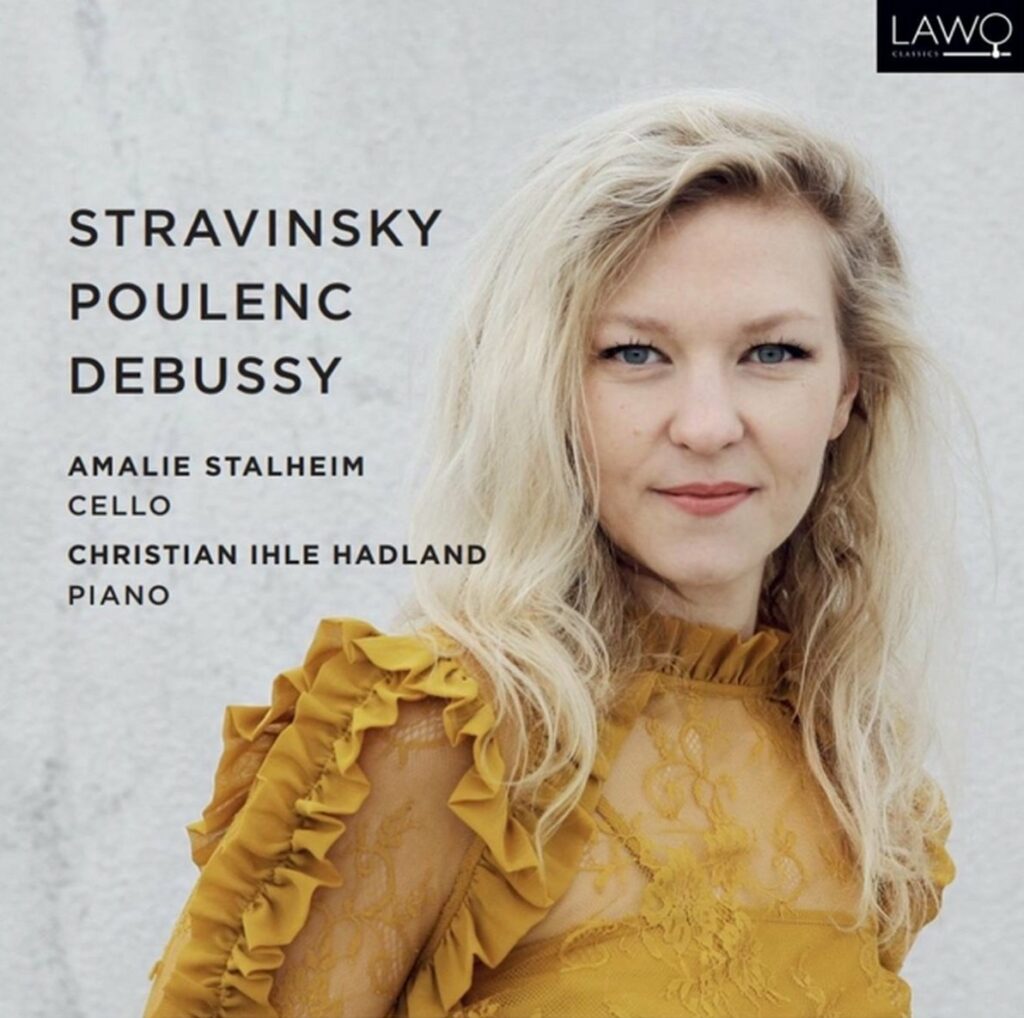Celliste Amalie Stalheim en pianist Christian Ihle Hadland brengen coherente uitvoeringen van werken van Stravinsky, Poulenc & Debussy.
English version below
In duo-repertoire is het samenspel van zeer groot belang. Belangrijk daarbij is dat de musici dezelfde interpretatie, frasering, dynamiek hanteren zodat, in dit geval, piano- en cellopartijen naadloos in elkaar grijpen. Dat vergt niet alleen een goede instrumentbeheersing maar ook een gedegen stijlkennis.
Het album Stravinsky, Poulenc & Debussy opent met de Suite Italienne van Igor Stravinksy uit 1932. Een suite die oorspronkelijk gecomponeerd is voor viool & piano, maar in 1932 herschreven voor cello & piano. Het werk is een selectie uit het Pulcinella-ballet dat Stravinsky in 1920 componeerde in opdracht van Diaghilev (met kostuums van Pablo Picasso). Een zeer melodieus zesdelig werk met cantabile thema’s die met diepgang en souplesse worden uitgevoerd. Zeker de Serenata klinkt met een fraaie emotionele lichtheid, tegenover de Tarantella die in een virtuoze snelheid veel indruk maakt. Een van origine snelle Zuid-Italiaanse 6/8ste dans die refereert aan de tarantella-spin. Een beet van deze spin zou dodelijk zijn, opzwepend dansen zou genezend werken.
De Cello Sonate van Francis Poulenc uit 1948 is een kenmerkend werk van deze Franse componist. Hij heeft een eigenzinnig gebruik van chromatiek en melodie-structuur, waarbij virtuoos spel en snel schakelend in timbre en stijl van groot belang zijn. Acrobatische muziek, clownesk bijna en heerlijk Poulenc-iaans. Een componist die eind jaren ’30 verandert van stijl . Zijn werken worden serieuzer en religieuzer, mede door de dood van zijn vriend Pierre Octave-Ferroud. De Cello Sonate is eigenzinnig met lyrisiche melodie-lijnen, afgewisseld met accelerando’s en complementaire piano- en cellowerk. In dit 4-delig werk is goed te horen hoe Stalheim en Ihle Hadland op elkaar zijn ingespeeld. Waar ze elkaar de ruimte geven, waar ze moeiteloos schakelen tussen de verschillende timbre’s en waar ze elkaar virtuoos aanvullen en uitdagen
De Cello Sonata in D-mineur van Claude Debussy is een expressief werk waarin snel gewisseld moet worden tussen de verschillende cello-technieken, waaronder pizzicato, flageolet en spiccato. Een kleurrijke en bijna ongrijpbare compositie met kenmerkend gebruik van de pentatonische en de hele-toonstoonladder. Ook in dit werk beluisteren we twee musici die met kalmte, rust en diepgang de muziek benaderen.
De uitvoeringen op het album Stravinsky, Poulenc & Debussy hebben een zelfverzekerde uitstraling. Hoe subtiel, ingetogen of ferm de uitvoeringen ook zijn, de muziek blijft gedecideerd. Daar spreekt niet alleen accurate instrumentbeheersing uit, maar ook bevlogenheid en bezieling.
English version
Cellist Amalie Stalheim and pianist Christian Ihle Hadland present a coherent performance of works by Stravinsky, Poulenc & Debussy.
In duo repertoire, really playing together is very important. The musicians have use the same interpretation, phrasing and dynamics so that, in this case, piano and cello parts mesh seamlessly. This not only requires good instrument control, but also a thorough knowledge of different styles.
The album Stravinsky, Poulenc & Debussy opens with the Suite Italienne by Igor Stravinksy from 1932. A suite originally composed for violin & piano but rewritten in 1932 for cello & piano. The work is a selection from the Pulcinella Ballet that Stravinsky composed in 1920 for Diaghilev (with costumes by Pablo Picasso). A very melodic six-part work with cantabile themes that are performed with depth and flexibility. Like the Serenata that sounds with a beautiful emotional lightness, compared to the Tarantella, which impresses in a virtuoso speed. An originally fast southern Italian 6/8th dance that refers to the tarantella spider. A bite from this spider would be deadly, dancing to this dance in a rousing way would be healing.
The Cello Sonata by Francis Poulenc from 1948 is a characteristic work of this lovely French composer. He has an idiosyncratic use of chromaticism and melody structure. Virtuoso and fast switching in timbre and style. It’s acrobatic music, almost clownish and wonderfully Poulenc-tian. A composer who changes his style in the late 1930s. His compositions become more serious and religious, partly due to the death of his friend Pierre Octave-Ferroud. The Cello Sonata is idiosyncratic with lyrical melody lines, interspersed with accelerandos and complementary piano and cello work. In this 4-part work you can clearly hear how Stalheim and Ihle Hadland do responded to each other. Where they give each other space, where they switch effortlessly between the different timbres and where they virtuoso complement and challenge each other
The Cello Sonata in D minor by Claude Debussy is an expressive work in which one has to switch quickly between the different cello techniques, such as pizzicato, flageolet and spiccato. A colorful and almost elusive composition with distinctive use of the pentatonic and whole-tone scales. In this work we also listen to two musicians who approach the music with calmness and tranquility.
The performances on the Stravinsky, Poulenc & Debussy album have a confident aura. No matter how subtle, subdued or firm the performances are, the music remains resolute. This not only expresses accurate instrument control, but also enthusiasm and inspiration.
*Amalie Stalheim / Christian Ihle Hadland: Stravinsky, Poulenc & Debussy (LAWO Classics)
© Mattie Poels.


Geen reacties